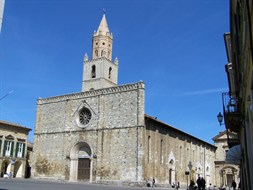The Abruzzo heart of the Duchy: Atri and Palazzo Acquaviva (second part)
 On the death of Giovanni Antonio Donato, Giovanni Girolamo I succeeded to the dukedom who, like his predecessors, loved to surround himself with writers and artists and continued to embellish his court. He extended the Ducal Palace in the east, turning it into a living theatre, where artists and writers flocked, and where he himself, a writer and poet, recited his compositions with his sister Dorotea, at the time a much sought after poetess. Since the end of the sixteenth century the descendants of Giovanni Girolamo I Acquaviva lived far from Atri and came only for short visits in Abruzzo, so the building fell into deep decline. A brief “rebirth” occurred at the end of the seventeenth century, thanks to Giovanni Girolamo II, who sojourned there few times with his wife. The building was remodeled on the outside, in order to make it less austere and more in line with the then dominant Baroque art: he built a cornice, which embraced the building in all its sides, but the most important innovation took place within, where Giacomo Farelli, an accomplished painter of the Neapolitan aristocracy, was asked to paint several rooms on the main floor of the building. In the honour hall he painted the Battle of Jupiter with the Giants and in an adjoining room the Life of Hercules, and in the audience hall, large oval portraits of all the dukes, duchesses and the most eminent members of the family, from Antonio onwards. In line with Neapolitan aristocratic culture, these artistic choices were intended to enhance the lineage and aristocratic way of life; but at the same time, military values, strength, “violence” continued to be fundamental for the family, and specifically for Giovan Girolamo, a military man serving Philip V. Today, unfortunately, very few of these paintings remain. The Ducal Palace was heavily hit by the Austrian troops during the War of the Spanish Succession and with the extinction of the Dukes of Acquaviva of Atri it became crown property under Charles of Bourbon (photo: Cathedral of Atri).
On the death of Giovanni Antonio Donato, Giovanni Girolamo I succeeded to the dukedom who, like his predecessors, loved to surround himself with writers and artists and continued to embellish his court. He extended the Ducal Palace in the east, turning it into a living theatre, where artists and writers flocked, and where he himself, a writer and poet, recited his compositions with his sister Dorotea, at the time a much sought after poetess. Since the end of the sixteenth century the descendants of Giovanni Girolamo I Acquaviva lived far from Atri and came only for short visits in Abruzzo, so the building fell into deep decline. A brief “rebirth” occurred at the end of the seventeenth century, thanks to Giovanni Girolamo II, who sojourned there few times with his wife. The building was remodeled on the outside, in order to make it less austere and more in line with the then dominant Baroque art: he built a cornice, which embraced the building in all its sides, but the most important innovation took place within, where Giacomo Farelli, an accomplished painter of the Neapolitan aristocracy, was asked to paint several rooms on the main floor of the building. In the honour hall he painted the Battle of Jupiter with the Giants and in an adjoining room the Life of Hercules, and in the audience hall, large oval portraits of all the dukes, duchesses and the most eminent members of the family, from Antonio onwards. In line with Neapolitan aristocratic culture, these artistic choices were intended to enhance the lineage and aristocratic way of life; but at the same time, military values, strength, “violence” continued to be fundamental for the family, and specifically for Giovan Girolamo, a military man serving Philip V. Today, unfortunately, very few of these paintings remain. The Ducal Palace was heavily hit by the Austrian troops during the War of the Spanish Succession and with the extinction of the Dukes of Acquaviva of Atri it became crown property under Charles of Bourbon (photo: Cathedral of Atri).
